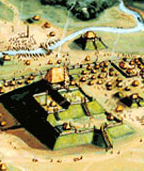| 
We do not know exactly what the religious beliefs of the Cahokians
were, but when authorities with background knowledge allow themselves
to speculate, the results are illuminating, especially about what
might have happened during religious celebrations or on the other
special occasions for which this elaborate sacred landscape was
designed and built. At the center of John Pfeiffer's imaginative
account in Indian City on the Mississippi lay four logs
pointing to the cardinal directions. Experts have recently provided
some convincing arguments that the story is largely accurate.
The evidence indicates that many Amerindian societies deliberately
planned their communities after a cosmic model. Henri-Fridiric
Amiel said in his nineteenth-century journal, "A landscape is
a condition of the spirit." Scholar Paul Wheatley put it another
way:
Sacrality (which is synonymous with reality) is achieved
through the imitation of a celestial archetype....Although the
whole world was the handiwork of the Gods its maximum potential
sacredness was realizable only at a few points. Before territory
could be inhabited, it had to be sacralized--that is cosmicized.
Its consecration signified its reality and therefore sanctioned
its habitation; but its establishment as an imitation of a celestial
archetype required its delimitation and orientation as a sacred
territory within a profane space.
With its plazas aligned on the cardinal directions and the mound
of greatest height at the crossing of the plazas, it is clear
that Cahokia is a landscape cosmogram. John E. Kelly advocates
looking for an explanation by approaching the question from both
ends of a chronological continuum. Did other Native American communities
create any analogous sacred landscape before the Cahokians? After
the Cahokians? The answer is yes to both questions. We know the
Hopewell circle-and-octagon mounds were used for sacred ceremonies
and for astronomical observations. We have seen the evidence of
a solar calendar at Poverty Point about 1500 B.C. Another pre-Cahokia
example is the McKeithen site at Weeden Island in northern Florida,
occupied between A.D. 200 and 700. Here three mounds form the
corners of an isosceles triangle, and a perpendicular from the
center of the baseline to the apex points toward the rising sun
at the summer solstice.
«
previous 3
of 8
next
»
|
 |

|
 |


Figure
#1: A setting for mythic rituals (William R. Iseminger) »
| M
O R E |
| Learn
more about Cahokia
in Bringing the Heavens to Earth. |
|
|
|